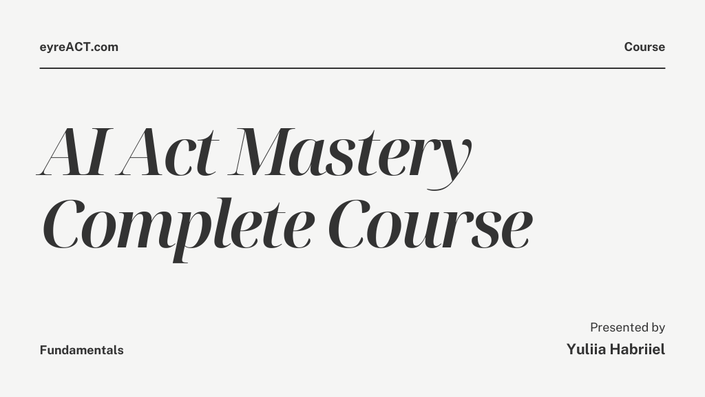EU AI Act Executive Summary
The European Union’s Artificial Intelligence Act (AI Act) is the world’s first comprehensive legal framework governing artificial intelligence systems. Adopted in 2024, it establishes a risk-based regulatory approach that categorizes AI systems according to their potential impact on safety, fundamental rights, and society.
The EU AI Act aims to foster innovation while ensuring AI development and deployment remain human-centric, trustworthy, and aligned with EU values.
Key Objectives
- Protect fundamental rights and ensure AI systems respect human dignity, privacy, and non-discrimination
- Enhance AI safety by establishing mandatory requirements for high-risk AI applications
- Promote innovation through regulatory clarity and support for AI development
- Create a unified market for AI across EU member states
- Establish global leadership in trustworthy AI governance
Risk-Based Classification System
The AI Act categorises AI systems into four risk levels:
Prohibited AI Practices in AI Act
- Social credit systems that evaluate individuals for government purposes
- Real-time biometric identification in public spaces by law enforcement (with limited exceptions)
- AI systems using subliminal techniques or exploiting vulnerabilities
- Emotion recognition systems in schools and workplaces
- Predictive policing systems based on profiling individuals
High-Risk AI Systems in AI Act
Applications that pose significant risks to safety or fundamental rights, including:
- Critical infrastructure management (transport, utilities)
- Educational assessment and admission systems
- Employment and HR (recruitment, performance evaluation)
- Access to essential services (credit scoring, insurance)
- Law enforcement (evidence evaluation, polygraph tests)
- Migration and border control systems
- Judicial decision-making support tools
- Biometric identification and categorization systems
Requirements for High-Risk Systems:
- Comprehensive risk assessment and mitigation
- High-quality training datasets
- Detailed documentation and record-keeping
- Transparency and information provision to users
- Human oversight mechanisms
- Robust accuracy and cybersecurity measures
- Conformity assessment and CE marking
Limited Risk AI Systems in EU AI Act
- Generative AI models (chatbots, content generators)
- Biometric categorization systems
- Emotion recognition systems (outside prohibited contexts)
Requirements:
- Clear disclosure of AI interaction to users
- Safeguards against generating illegal content
- Protection of copyrighted material
- Risk assessment and mitigation measures
Minimal Risk AI Systems in EU AI Act
- Spam filters
- Basic recommendation systems
- Simple chatbots
- AI-enabled video games
No specific obligations beyond general product safety laws.
Foundation Models and Generative AI in EU AI Act
General-Purpose AI Models (GPAIs)
- Systemic risk threshold: Models requiring more than 10^25 FLOPs for training
- Obligations: Risk assessment, safety testing, incident reporting, cybersecurity measures
- Documentation requirements: Model cards, training data information, evaluation results
Provider Responsibilities
- Implement safeguards against generating harmful content
- Design systems to prevent generation of illegal content
- Publish detailed summaries of copyrighted training data
- Establish quality management systems
- Monitor and report serious incidents
Governance Structure in EU AI Act
EU Level
- AI Office: Central coordination and enforcement for foundation models
- AI Board: Strategic guidance and coordination between member states
- Scientific Panel: Independent expert advice on technical matters
National Level
- Market surveillance authorities: Monitor compliance and enforcement
- Notifying authorities: Oversee conformity assessment bodies
- Data protection authorities: Handle fundamental rights violations
Industry Level
- Conformity assessment bodies: Third-party evaluation of high-risk systems
- Standardization organizations: Develop harmonized standards
Compliance Timeline
- August 2024: Act enters into force
- February 2025: Prohibited practices ban takes effect
- August 2025: Governance structure fully operational
- August 2026: Foundation model obligations begin
- August 2027: Full compliance required for all high-risk systems
Penalties and Enforcement of EU AI Act
Financial Penalties
- Prohibited AI practices: Up to €35 million or 7% of annual global turnover
- High-risk system violations: Up to €15 million or 3% of annual global turnover
- Foundation model violations: Up to €7.5 million or 1.5% of annual global turnover
- Information request non-compliance: Up to €7.5 million or 1% of annual global turnover
Administrative Measures
- Market withdrawal orders
- Product recalls
- Service suspension
- Temporary bans on AI system operation
Business Implications of EU AI Act
For AI Developers
- Increased compliance costs for risk assessment and documentation
- Market access advantages through CE marking and regulatory clarity
- Innovation incentives through regulatory sandboxes and support programs
- Global competitive advantage in trustworthy AI markets
For AI Deployers
- Due diligence requirements when procuring AI systems
- Transparency obligations to end users and stakeholders
- Risk management integration into business processes
- Human oversight implementation requirements
For End Users
- Enhanced transparency about AI system capabilities and limitations
- Stronger fundamental rights protection against AI-related harms
- Clear recourse mechanisms for AI-related disputes
- Improved AI literacy through information requirements
Global Impact of EU AI Act
The EU AI Act is expected to have significant extraterritorial effects:
- Brussels Effect: Global companies may adopt EU standards worldwide
- Regulatory benchmark: Other jurisdictions using the Act as a model
- Trade implications: Compliance requirements for AI systems entering EU market
- Innovation influence: Shaping global AI development priorities
Implementation Challenges of EU AI Act Regulations
Technical Challenges
- Standard development: Creating harmonized technical standards
- Risk assessment methodologies: Developing practical evaluation frameworks
- Conformity assessment: Establishing reliable third-party evaluation
- Cross-border coordination: Ensuring consistent enforcement
Business Challenges
- Compliance costs: Particularly burdensome for SMEs
- Innovation pace: Balancing regulation with rapid technological development
- International coordination: Managing different global regulatory approaches
- Skills shortage: Need for AI governance and compliance expertise
Final Thoughts
The EU AI Act represents a landmark achievement in AI governance, establishing the world’s most comprehensive regulatory framework for artificial intelligence. While implementation challenges remain significant, the Act provides essential foundations for trustworthy AI development and deployment. Success will depend on effective collaboration between regulators, industry, and civil society to ensure the framework achieves its dual objectives of protecting fundamental rights while fostering innovation.

